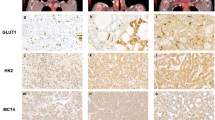Abstract
To evaluate whether thallium-201 scan can reflect tumour proliferative activity in thyroid nodules. We compared the degree of 201T1 uptake with the tumour proliferative ability as assessed immunohistochmically by the labelling index of proliferating cell nuclear antigen (PCNA) in malignant and benign thyroid nodules. The case material comprised ten benign and 31 malignant surgically resected nodules from a total of 41 patients.201TI scan was performed 5 min (early scan) and 2 h (delayed scan) after intravenous injection of 74 MBq of201Tl. The degree of201TI uptake was visually divided into three grades [from (-) to (++)], as compared with its uptake in normal adjacent thyroid tissue. Immunohistochemical staining of PCNA was performed using a monoclonal antibody for PC 10 on paraffin-embedded specimens. On both the early and the delayed scans, the mean PCNA index in the nodules with an intense201T1, i.e. (++), was significantly higher than that in nodules with a lower or with negative 201T1 uptake. The correlation was higher on the delayed 201T1 scan (P=0.009) than on the early scan (P=0.019). Our results indicate that201TI uptake may reflect the tumour proliferative activity of thyroid nodules, and this is especially true with regard to the uptake on delayed scans.
Similar content being viewed by others
References
Shimizu T, Usuda N, Yamada T, etal. Proliferating activity of human thyroid tumors evaluated by proliferating cell nuclear antigen/cyclin immunohistochemical studies.Cancer 1993; 71:2807–2812.
Elligsen JD, Thompson JE, Kruuv J. Correlation of (Na+-K+)-ATPase activity with growth of normal and transformed cells.Exp Cell Res 1974; 87: 233–240.
Kishida T, Knazawa K, Nagano K. Na+,K+-ATPase activity in thyroid nodules. Mechanism of thallium-201 accumulation in the thyroid glands.J Clin Exp Med 1986; 139: 527–528.
Black KL, Hawkins RA, Kim KT, etal. Use of thallium-201 SPECT to quantitate malignancy grade of gliomas.J Neurosurg 1989; 71: 342–346.
Ito Y, Muranaka A, Harada T, etal. Experimental study of tumor affinity of201TI-chloride.Eur J Nucl Med 1978; 3: 81–86.
Ando A, Ando I, Katayama M, etal. Biodistribution of 201 TI in tumor bearing animals and inflammatory lesion induced animals.Eur J Nucl Med 1987; 12: 567–572.
Suga K, Nishigauchi K, Fujita T, etal. Experimental evaluation of the usefulness of201TI-chloride scintigraphy for monitoring radiotherapeutic effects.Nucl Med Commun 1994; 15: 128–139.
Coltrera MD, Gown AM. PCNA/cyclin expression and BrdU uptake define different subpopulations in different cell lines.J Histochem Cytochem 1991; 39: 23–30.
Tsuji T, Sheresta P, Yamada K, etal. Proliferating cell nuclear antigen in malignant and pre-malignant lesions of epithelial origin in the oral cavity and the skin: an immunohistochemical study.Virchows Arch A Pathol Anat 1992; 420: 377–383.
Hall PA, Levison DA, Woods AL, etal. Proliferating cell nuclear antigen (PCNA) immunolocalization in paraffin sections: an index of cell proliferation with evidence of deregulated expression in some neoplasms.J Pathol 1990; 162: 285–294.
Robbins BA, Vega D, Ogata K, etal. Immunohistochemical detection of proliferating cell nuclear antigen in solid human malignancies.Arch Pathol Lab Med 1987; 111: 841–845.
Takeda K, Yamada N, Asano G. Immunohistochemical study of borderline thyroid lesions with special reference to relationships among nuclear features, type IV collagen and malignancy of follicular lesions.Arch Otorhinolaryngol 1993; 96: 2057–2064.
Kusunoki T, Nakano T, Funasaka K, etal. Proliferating cell nuclear antigen (PCNA) on human diseased thyroid cells.Arch Otorhinolaryngol 1992; 96: 651–658.
Actolum C, Bayhan H, Kir M. Clinical experience with Tc99m MIBI imaging in patients with malignant tumors. Preliminary results and comparison with T1-201.Clin Nucl Med 1992;17:171–176.
Földes I, Levay A, Stotz G. Comparative scanning of thyroid nodules with technetium-99m pertecnetate and technetium99m methoxyisobutylisonitrile.Eur J Nucl Med 1993; 20: 330–333.
Vattimo A, Bertelli P, Cintorino M, etal. Identification of Hürthle cell tumor by single-injection, double-phase scintigraphy with technetium-99m-sestamibi.J Nucl Med 1995; 36: 778–782.
Sisson JC, Ackermann RJ, Meyer MA, etal. Uptake of 18-fluoro-2-deoxy-d-glucose by thyroid cancer. Implications for diagnosis and therapy.J Clin Endocrinol Metab 1993; 77: 1090–1094.
Joensuu H, Ahonen A, Klemi PJ.18F-fluorodeoxyglucose imaging in preoperative diagnosis of thyroid malignancy.Eur J Nucl Med 1988; 13: 502–506.
Ochi H, Sawa H, Fukuda T, etal. Thallium-201-chloride thyroid scintigraphy to evaluate benign and/or malignant nodules. Usefulness of the delayed scan.Cancer 1982; 50: 236–240.
Author information
Authors and Affiliations
Rights and permissions
About this article
Cite this article
Kume, N., Suga, K., Nishigauchi, K. et al. Relationship between thallium-201 uptake and tumour proliferative ability in thyroid nodules. Eur J Nucl Med 23, 376–382 (1996). https://doi.org/10.1007/BF01247364
Received:
Revised:
Issue Date:
DOI: https://doi.org/10.1007/BF01247364




